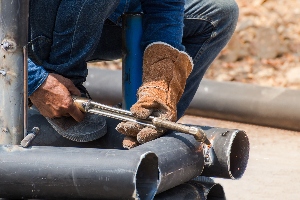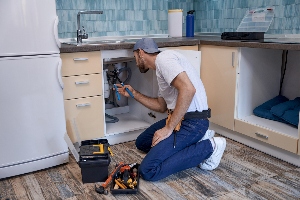Installing a water heater is a task that requires careful planning and attention to detail. Whether one is replacing an old unit or installing a brand new system, understanding the basics can lead to a safer and more efficient setup. Before beginning the installation process, one must consider the type of water heater that best suits their needs, be it a traditional storage-tank model or a more modern tankless version. It's essential to evaluate the energy source—gas or electric—as this influences the installation requirements and procedures.
It's important that installers adhere to local building codes and regulations, which may dictate specific safety measures and installation standards. This includes securing necessary permits and ensuring that the location and setup fulfill the code requirements. When preparing for installation, one should account for the necessary space, ventilation, and connections. Proper venting is crucial for gas water heaters, as it prevents the buildup of dangerous gases, while electric models require an adequate electrical supply.
The choice and placement of a water heater can have long-term implications for energy efficiency and utility expenses. Insulation and temperature settings must be considered to optimize performance. Moreover, precautionary steps such as the installation of a drain pan and the use of seismic straps in earthquake-prone areas can mitigate the risks of water damage and unit displacement. With thorough preparation and a methodical approach, water heater installation can be executed effectively, ensuring reliable hot water for household needs.
Choosing the Right Water Heater
When installing a water heater, selecting the appropriate type, size, and energy efficiency is crucial for optimal performance and cost savings.
Types of Water Heaters
Water heaters come in various forms, each serving different needs. Storage tank water heaters are the most common, and they operate by heating water in a tank and keeping it warm until it’s needed. Tankless or on-demand water heaters heat water directly without the use of a tank, providing a continuous supply of hot water and typically consuming less energy. Heat pump water heaters move heat from one place to another instead of generating heat directly for providing hot water, which can be more energy-efficient than traditional tank water heaters. Solar water heaters use the sun's energy to heat water, and they're an eco-friendly option especially in sunny regions.
Size and Capacity
It’s important to choose a water heater with the right capacity to meet a household’s needs. A too small unit will run out of hot water, while an excessively large one will waste energy. The capacity for tank water heaters is typically measured in gallons, with 40 to 60 gallons being common for residential use. Tankless models are rated by the gallons per minute (GPM) of hot water they can produce; you'll want to consider the number of devices you intend to run simultaneously.
Energy Efficiency Considerations
Energy efficiency is a key factor in selecting a water heater. Look for the Energy Factor (EF) or Uniform Energy Factor (UEF) ratings when comparing units. Higher ratings indicate more efficient models that could save energy and reduce operating costs over time. There are also Energy Star certified models that meet strict energy efficiency guidelines set by the U.S. Environmental Protection Agency.
Cost Analysis
Evaluating the cost includes more than just the purchase price; initial installation, operating costs, maintenance, and potential rebates should all be considered. Storage tank water heaters typically have a lower initial purchase price. In comparison, tankless, heat pump, and solar water heaters often have higher upfront costs but can provide significant savings in the long run through lower operating costs. Maintenance costs should also be factored in, as some water heaters require more frequent maintenance than others.
Pre-Installation Preparation
Proper preparation ensures a smooth installation process for a new water heater. This involves obtaining necessary permits, assembling tools and materials, and safely removing the old unit.
Acquiring Permits
Before starting the installation, it's essential to obtain the correct permits. Local building codes vary, so the homeowner must check with their municipality. Typically, permits ensure the installation complies with safety regulations.
Tools and Materials
The installer will need a range of tools and materials for the job. A basic list includes:
- Pipe wrenches
- Screwdrivers
- Teflon tape
- Tubing cutter
- Soldering equipment
- Voltage tester
- Gas leak detector (for gas heaters)
Materials may include:
- Pipes and fittings
- Discharge pipe
- Water heater stand or straps (if required)
Old Water Heater Removal
Removal of the old water heater is a critical step. First, turn off the power or gas supply and drain the tank. Disconnect the water supply lines, gas or power connections, and the flue pipe for a gas heater. Once everything is disconnected, the old water heater can be safely removed.
Installing the New Water Heater
Proper installation of a new water heater is critical for ensuring efficiency and safety. Attention to detail during each step can prevent issues down the line.
Positioning the Unit
The new water heater should be placed on a level surface, ideally on a platform or stand if necessary to prevent potential flood damage. It should be readily accessible for maintenance and positioned away from high traffic areas to avoid physical damage. Maintaining at least a few inches of clearance around it is important for adequate ventilation and code compliance.
Connecting Water Supply
Cold Water Line: Attach the cold water supply line to the designated inlet on the water heater using suitable pipe connections and sealants to prevent leaks. Ensure that a shut-off valve is installed for future maintenance and emergency purposes.
Hot Water Line: Similarly, connect the hot water line to the water heater outlet. Use dielectric unions if connecting dissimilar metals to prevent corrosion.
Electrical and Gas Connections
Electrical Units: If the unit is electric, it should be connected to its own circuit breaker. Electrical connections must be made according to the local electrical codes, and typically require a high-voltage cable and a proper conduit.
Gas Units: For gas water heaters, ensure the gas line connection is leak-free and secure. Use a gas-rated pipe thread compound on fittings. Once installed, the gas supply can be turned on and the pilot light ignited according to the manufacturer's instructions.
Final Steps and Inspection
Upon completing the connections, it is important to fill the tank with water and check all fittings for leaks. Once the tank is full and all air has been purged from the pipes, the heating elements can be turned on. An inspection by a qualified professional is recommended to ensure that the installation meets all local codes and safety standards. This final step validates the installation and provides peace of mind about the safety and efficiency of the new appliance.
Post-Installation
Once a water heater is installed, effective maintenance and readiness to address potential issues are essential for longevity and performance.
Maintenance Tips
- Regular Inspections: Schedule bi-annual inspections to check for any signs of wear or damage. Look for corrosion or leaks at fittings and connections.
- Anode Rod Replacement: An anode rod prevents corrosion inside the tank. Check it annually and replace as needed, typically every 3-5 years.
Troubleshooting Common Issues
- No Hot Water: If the unit is electric, check the circuit breaker. For gas units, ensure the pilot light is lit and check for gas supply issues.
- Water Temperature Problems: Adjust the thermostat setting. If still unresolved, test the thermostat and heating element (electric) or gas burner (gas).
Professional Services and Support
- Warranty Service: Keep the water heater's warranty documentation accessible and contact the manufacturer for issues covered under warranty.
- Expert Assistance: For complex issues, consult a licensed plumber. Regular servicing from a professional can prevent many common problems.












